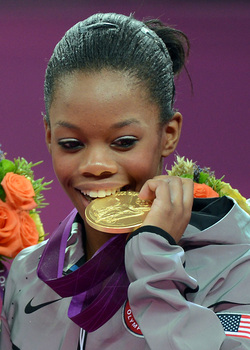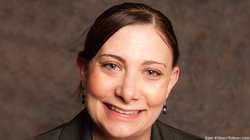 By Yoon Joung Lee An American artistic gymnast, Gabrielle Christina Victoria “Gabby” Douglas, was born in 1995 in Virginia Beach, Virginia as one out of three siblings. She started her training at age six as her older sister convinced their parents to enroll her in gymnastics classes. There, Douglas met her coach, Dena Walker at Excalibur Gymnastics in Virginia Beach. Just two years later, when she was eight, she won the Level 4 all-around gymnastics title at the 2004 Virginia State Champion-ships. When Douglas turned 14, she left her family in Virginia Beach and moved to West Des Moines, Iowa to train with elite coach, Liang Chow. With Chow’s coaching, Douglas placed fourth all-around at the 2010 Nastia Liukin Supergirl Cup. That same year, she competed at the 2010 CoverGirl Classic in Chicago, IL. In 2011, she made her senior debut. She tied for third on bars and placed seventh all-around at the 2011 U.S. National Championships. Douglas also competed as a member of the 2011 World Championship Team in Tokyo, Japan and her team won gold. In 2012, she received the highest total all-around score in the womens’ competition at the AT&T American Cup but her score didn’t count because she was an alternate. That same month, she competed with the U.S. team at the Pacific Rim Championships. Although Douglas injured her ankle during the competition, she won gold on the uneven bars in the event finals. Douglas beat her teammate and competitor, Jordyn Wieber, for the overall title at the 2012 Olympic Trials in San Jose, CA and showed people she was a legitimate contender for the Olympic all-around title, as well. At the 2012 London Olympics, Douglas competed for the U.S. at all four events in the team finals and earned 61.465 total around score. Her performance was vital for team USA’s gold medal victory. Douglas also earned 62.232 in the all-around final. She also won the all-around-gold individual medal, becoming the first African American gymnast to do so. Douglas and her teammates were featured on the cover of Sports Illustrated for the 2012 Olympic Preview Issue and appeared on Rock Center with Bridal Williams. She was also featured on one of five Time magazine Olympic covers. After the 2012 London Olympics, she appeared on The Tonight Show with Jay Leno.  by Yoon Young Lee The Research and Policy Coordinator for Bullying Prevention Initiatives at the US Department of Education, Deborah Temkin, leads the government-wide campaign against bullying. She works for all the activities in the Department that relate to bullying prevention, including 9 federal agencies and the Bullying Prevention Working Group who are working for reducing peer bullying in American Schools and StopBullying.gov. Temkin planned various educational events, played the role of a voice for isolated adolescents, and designed research projects. She, as the bullying prevention coordinator, was mainly managing and executing the Federal Partners in Bullying Prevention Summits in 2010. In 2011, she also centrally contributed to the White House Conference on Bullying Prevention. Her life course turned to bullying prevention because of her painful adolescent memories from middle school. Temkim had a falling out over the school newspaper as her close school friend turned into an archenemy who led most of her classmates against her. One day, she was pushed from school bus windows and thrown into a water fountain. She broke her tooth. Those painful memories led Temkin into a successful career, leading and coordinating various federal governments’ anti-bullying campaigns with 9 departments and 32 offices. From her own experience, she realized that understanding the roots of bullying is very vital for prevention and that the school is innately responsible, rather than the kids who lead the bullying. Therefore, helping schools find effective strategies to stop is important. In 2012, such rapid success put her in the running for a Samuel J. Heyman Service to America Medal for outstanding public service. She was named as one of 33 finalists and 9 of those will be awarded medals by the nonprofit Partnership for Public Service in this fall.  By Yoon Young Lee An American physicist and astronaut, Sally Kristen Ride, was born and grew up in 1951 in California, U.S. She was born into a conservative Presbyterian church. Both her parents were elders for the church. Her father was a political science professor at Santa Monica College and her mother was a volunteer counselor at a womens’ correctional facility. When she was young, she was not only interested in science, but tennis. She was a ranked tennis player. When she completed her master’s degree and a Ph.D at Stanford, she coincidentally read a newspaper advertisement about seeking applicants for NASA's space program. After beating out 1000 other applicants for a spot in NASA’s astronaut program in 1978, she joined NASA and got a chance to go into space and the record books in 1983. That was her first trip to space and she became the first American woman in space aboard the space shuttle Challenger. She came back to Earth after 6 days. In 1984, she took her second trip as a mission specialist on a space shuttle flight. There, she spent about 343 hours in space. When she came back, she finished 8 months of training for her third flight. However, the tragic Challenger explosion in 1986 made her cancel her plans for further flights into space. After the accident, she moved to Washington, D.C. to investigate the space shuttle explosion as she served on the presidential commission which was named to the Rogers Commission Report. In 1987, she left her position in Washington, D.C. and worked at Stanford University Center for International Security and Arms Control. In 1989, she taught at the University of California, San Diego as a professor of physics. In 2001, she founded her own company, Sally Ride Science, to create entertaining science programs and publications to help inspire young women to pursue their interests in science and math. For her significant contributions to the field of science and space exploration, Ride won many awards including the NASA Space Flight Medal, the NCAA’s Theodore Roosevelt Award, the National Women’s Hall of Fame, and the Astronaut Hall of Fame. After a 17 month battle with pancreatic cancer, she died at the age of 61 in 2012 in La Jolla, California. |
Archives
July 2017
Categories
All
|
 RSS Feed
RSS Feed